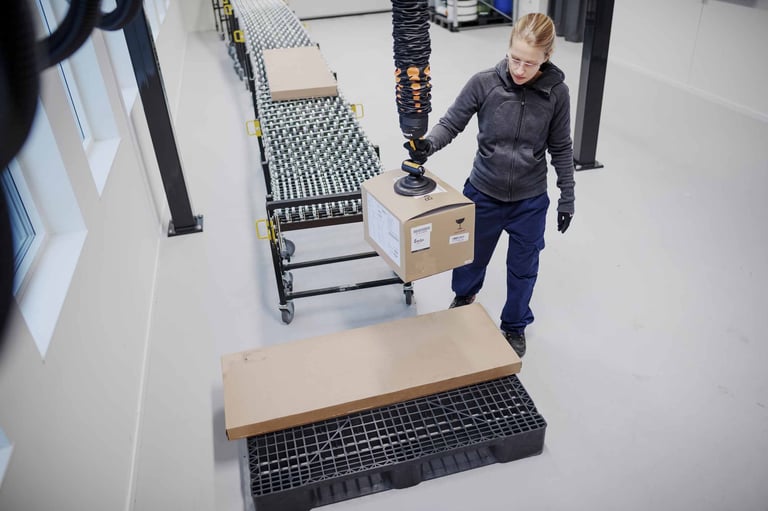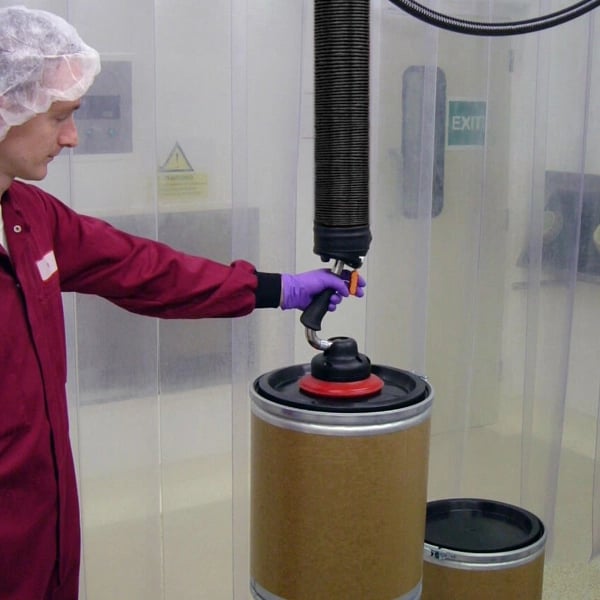Lifting Safety | Safe Lifting Using Vacuum Technology

Compared to manual handling, vacuum lifting is not only much more efficient – it also reduces or even eliminates many of the short-term and long-term health risks. Using vacuum powered lifting aids, anyone can handle heavy loads without effort and in ergonomically correct positions.
Safe lifting techniques
Lifting heavy objects is one of the main causes of injury in the workplace. Strains and sprains from lifting loads improperly, or from carrying loads that are either too large or too heavy are common hazards associated with manually moving materials. Using safe lifting techniques is a first step to improving lifting safety and minimizing workplace injuries. However, not all lifts can be carried out safely without using some type of lifting aid. Utilizing vacuum lifters or other types of manual handling lifting aids will ensure that lifts are performed in a safe way, reducing the strain on the worker, and thereby minimizing the risk of injury. Learn more about preventing work-related injuries here.
Workplace lifting safety
Although vacuum lifting is one of the safest types of lifting, it is important to remember that any type of lifting can be hazardous. As with any material handling solution, it is important that the equipment is properly maintained and that the operator knows how to safely use it. This article is intended as a brief overview of some of the important lifting safety principles when lifting with vacuum tools.
As with other lifting equipment, one of the main hazards when using vacuum lifting technology is falling or laterally displaced loads. Extra care must be taken when lifting loads with a higher potential to cause injury, such as heavy objects.
It is also important to know that a vacuum lifting device is typically designed for specific materials and should not be used as a general-purpose lifting device. That a load is smaller and weighs less does not necessarily make it safe to lift. For example, the vacuum pump flow rate required to lift a porous bag is higher compared to the requirements for lifting a significantly heavier steel sheet.

Lifting Safety: General Guidelines
Any risks can be kept to a minimum as long as the lifting equipment is properly maintained and that the operator fully understands how to use it. A list of general safety guidelines (non-exhaustive) include:
- An operator must never attempt a lifting procedure without being trained on the specific vacuum lifting device.
- Always follow the instructions in the manual.
- Avoid using a vacuum lifting device to lift other types of loads than those it was designed to handle.
- When starting the lift, ensure that the system achieves a strong vacuum grip between the load’s surface and the suction feet.
- Be aware of the vacuum lifting equipment’s limitations – never exceed its maximum lifting capacity or attempt to lift multiple items at once.
- Do not use the vacuum lifter to move damaged loads, as this may result in an insufficient vacuum grip.
- Ensure that there is no possibility of a person being hit by displaced loads or stuck between loads.
- Do not leave loads suspended.
- Never allow people to pass beneath a suspended load.
- Stay clear of the area above the vacuum lifting handle and other maneuvering parts. In the case of a very strong vacuum grip and quick evacuation of the system, loads may be lifted unexpectedly fast.
- When using a mobile vacuum lifter, do not transport a load while suspended.
- Attempt to move vacuum-suspended loads at the lowest height possible.
- Ensure that your facility is prepared to deal with an accident.
- Never modify or attempt to repair the equipment without consulting a specialist.
- Keep the lifting system clean and dry. Avoid water coming into contact with the vacuum pump or electrical cables.
Maintenance – A Key Part of Workplace Lifting Safety
Vacuum lifting system modifications and repairs should always be performed by qualified service technicians, but routine inspections by the operator are also an important part of lifting safety. As an example, these inspections are to be carried out on a weekly basis by an operator of the TAWI Multifunctional lifter (simplified):
- Make sure that the yearly service inspection date is valid.
- Check bolts and nuts for wear or damage.
- Check that the safety valve operates correctly. If case of a power failure, this valve automatically closes, and the load slowly sinks to the floor. A test is performed by gripping a load and turning off the vacuum pump. A controlled sinking motion should be observed.
- Check all connecting components, such as clamps, bolts and pins.
- Clean the air filters in the suction foot and filter unit. This action may have to be performed more than once a week if required by the working environment.
- Check the lift and air tubes for any signs of wear or damage.
- Verify that the lifting capacity, warning and operating signs are visible.
- Ensure that the lift runs smoothly in the jib rig or crane system.
- Verify that the operating valve is functioning properly.
- Test the device to ensure that it achieves its maximum lifting capacity. It should be able to hold its designated load easily. Reduced lifting capacity indicates a vacuum leak.
Other than routine inspections by the operator, a more comprehensive service is typically performed by an inhouse maintenance team or a service technician on a recurring but less frequent basis. If significant wear or damages are detected during an inspection process, lifting should be halted immediately until the device is repaired by qualified service staff. Contact the manufacturer when in doubt.
In summary, vacuum lifting is one of the safest alternatives in material handling as long as the operator is adequately trained to handle the equipment, and provided that the equipment is serviced according to specifications. This will allow for highly efficient, ergonomically correct, and largely effortless lifting.
Would you like further advice on how to improve your workplace lifting safety? Get in touch with TAWI for a free consultation.